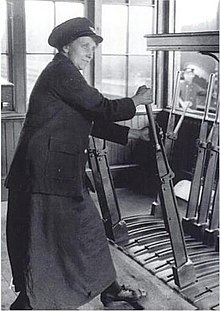
A signalman or signaller is an employee of a railway transport network who operates the points and signals from a signal box in order to control the movement of trains.

A signalman or signaller is an employee of a railway transport network who operates the points and signals from a signal box in order to control the movement of trains.
The first signalmen, originally called Railway Policemen (leading to the nickname of 'Bobby'), were employed in the early 19th century and used flags to communicate with each other and train drivers. The railways were already in existence by then and The British Transport police say that,"early railway policemen were probably sworn in as special constables under a statute passed in 1673 during the reign of Charles II. They were appointed to preserve law and order on the construction site of the railway patrol and protect the line control of the movement of railway traffic. [1] ) and hourglasses for the purpose of Time Interval Working between stations.)[ citation needed ]
In South Africa, a local rail signaller named Jack achieved some fame for the unique distinction of being a chacma baboon. [2]
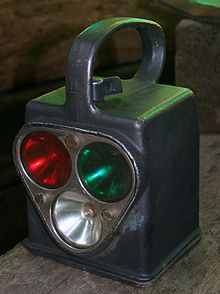
It was a signalman's duty to check each train that passed their signal box, looking for the red tail lamp exhibited on the trailing vehicle, the sighting of which confirmed that the train was still complete, and thus the section was clear.
Each train movement was logged, by hand, in a Train Register Book, and it was normal practice to provide a special desk to support this sizeable book. As well as train movements, every communication between signalmen and adjacent signal boxes via bell codes (when accepting trains or dealing with a token) was logged.
Technological advances including mechanical fixed signals in the 1840s, the electric telegraph and block working in the 1850s, and proper mechanical interlocking from 1856, allowed safer, more expeditious train working, and more complicated track layouts to be controlled single-handedly. The advent of such technological advances gradually led to the provision of an enclosed workspace known as a signal box, signal cabin or interlocking tower.
The principles of British-style railway signalling have changed little since the Victorian era and early 20th century. Modern technology has generally reduced the labour required per train movement. In many cases, a switch, button or computer command is used to alter the lie of points and control signals. Although many classic mechanical signal boxes remain in use, these are gradually being replaced by modern power signalling systems on most railways. The heartlands of British-style railway signalling could be said to be the United Kingdom, New South Wales, Victoria, Queensland, India and South Africa.
The signaller's main duty is to ensure trains get from A to B safely and on time. The classic Train Register Book remains in use at most older installations, with train describers and Automatic Train Recording taking its place in more modern power signalling schemes. All trains are listed in a computer system in the UK in time order. This system is known as TRUST. Any train can be found on here together with its schedule and route. If a train is late, it is up to the signaller to ascertain in what order the trains should run, known as regulating trains.
In busy locations, signalling can be very challenging and stressful, in a manner similar to air traffic control. Signallers are therefore susceptible to stress-related illness. Following protracted industrial action from unions and, much more recently, detailed studies on fatigue and ergonomics in the rail industry, [3] [4] prudent operators implemented strict guidelines relating to the length and number of consecutive shifts permissible for safety-critical workers, including signallers. These guidelines are ideally aimed at improving safety and reducing fatigue at work, but also the overall lifestyle of employees. In some cases, physical changes in the work environment also followed these studies, including changes in the design of signal box lighting, seating and signalling equipment.
The signalman is known by various other corporate job titles, including Signaller, Area Controller and Network Controller. In the United States, a signalman is sometimes officially known as such, but is also known under other names, including Leverman and Switchman. At some locations, a Station master or Porter performs signalling duties in addition to other work such as selling tickets and cleaning. Although the positions of Train Controller and Signalman were always distinct from the inception of the former in 1907, Train Controllers perform work previously executed by Signalmen in some cases. In many railways, modern technology has seen the positions of Signalman and Train Controller united (or reunited, in the sense that traffic regulation and train path allocation were originally duties of the Signalman anyway). Irrespective, the classic Telephone Train Control system has been generally abolished, with a few exceptions.
To improve the efficiency of train working, train controllers (also known as controllers, district controllers, line controllers and area controllers) were progressively introduced on many British-style railways in the early years of the 20th century, the first being on the Midland Railway in 1907. Although the specifics of their duties varied between railways, train controllers were responsible for tracking train movements (especially freight), ensuring freight trains were loaded economically and provided with suitable locomotive power, liaising with train crew rostering personnel, ordering additional trains to run for the carriage of extra freight tonnage or passengers as required, allocating paths for unscheduled services and making alterations to scheduled working in order to maximize efficiency and deal with any irregularity in traffic which may affect smooth operation. On busy railways such as the Midland, it was at times very difficult for signalmen to keep track of train movements and make optimal traffic regulation decisions whilst operating signalling equipment. Consequently, fast trains could be delayed by slower trains on the line ahead. Moreover, there was no-one with specific responsibilities relating to the efficient, economical use of rolling stock in traffic, which made it difficult to manage the contingencies of underutilisation, wastage and allocation of inappropriate locomotive power. In the face of rising costs, operating economies were particularly important to the private British railway companies in the early twentieth century. The Train Controller was intended to manage these and other difficulties. It is important to note that while Train Controllers were responsible for traffic regulation within their areas of control, they generally had no safety-critical responsibilities, which were within the realm of the signalmen and station masters. [5] [6] [7]
Typically, train controllers were stationed at district or "divisional" control offices which were linked by omnibus circuit [ clarification needed ] telephone systems with selective code rings, to all signal boxes in the area. This method of operating was sometimes known as the Telephone Train Control System. If the signalman required directions, he simply lifted the receiver and spoke to the train controller on the omnibus circuit. If the train controller wanted to issue instructions or receive train arrival and departure times, he selected the relevant signal box on his telephone, which rang the control phone therein. There were two main problems with this system. Firstly, the train controllers could become overloaded with path requests from signalmen, train recording and other duties. This led to delays for signalmen waiting for their turn to speak on the omnibus circuit, making the role of the train controller somewhat self-defeating. Secondly, signalmen were often in a better position to make train working decisions by virtue of their experience and by being on the spot, but were prevented from doing so by bureaucratic procedures. In silent admission of the deficiencies of this system, signalmen were generally left to their own devices, especially in the event of a general disruption to train services, during which the train control system simply could not handle the demands placed upon it.
In exceptional cases, district control offices were abandoned and train controllers appointed at key signal boxes (as in the London Midland Region of British Railways in the late 1960s), obviating the need for telephonic communication. This practice was followed by what has been the norm since the introduction of modern power signalling schemes, viz. the traditional train controller's substitution by a senior signalman, signal box supervisor or traffic regulator, situated in the signal box.
In the UK, the beginning of the end for classic "Control" came with the commissioning of large power signal boxes from the 1950s. A power signal box (PSB) often has a number of signalmen operating multiple electric or computerized signalling panels and large illuminated track diagrams showing wide areas of operation. This makes traffic regulation much easier for signalmen to handle among themselves. In some cases, a traffic regulator is appointed, who may be consulted for train working decisions. Following the accident at Ladbroke Grove in 1999, it was resolved that supervisors should be appointed at key signal boxes. However, these supervisors are not train controllers. Similar appointments have been made at major signal boxes in New South Wales since 2003.
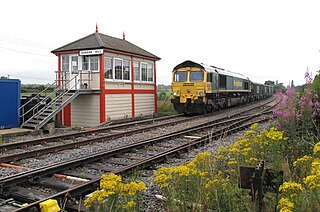
On a rail transport system, signalling control is the process by which control is exercised over train movements by way of railway signals and block systems to ensure that trains operate safely, over the correct route and to the proper timetable. Signalling control was originally exercised via a decentralised network of control points that were known by a variety of names including signal box, interlocking tower and signal cabin. Currently these decentralised systems are being consolidated into wide scale signalling centres or dispatch offices. Whatever the form, signalling control provides an interface between the human signal operator and the lineside signalling equipment. The technical apparatus used to control switches (points), signals and block systems is called interlocking.

Railway signalling (BE), also called railroad signaling (AE), is a system used to control the movement of railway traffic. Trains move on fixed rails, making them uniquely susceptible to collision. This susceptibility is exacerbated by the enormous weight and inertia of a train, which makes it difficult to quickly stop when encountering an obstacle. In the UK, the Regulation of Railways Act 1889 introduced a series of requirements on matters such as the implementation of interlocked block signalling and other safety measures as a direct result of the Armagh rail disaster in that year.

The Quintinshill rail disaster was a multi-train rail crash which occurred on 22 May 1915 outside the Quintinshill signal box near Gretna Green in Dumfriesshire, Scotland. It resulted in the deaths of over 200 people and remains the worst rail disaster in British history.
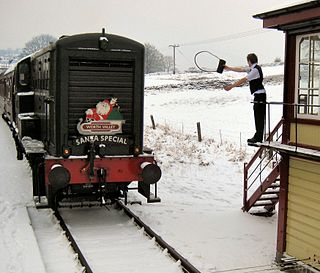
In railway signalling, a token is a physical object which a train driver is required to have or see before entering onto a particular section of single track. The token is clearly endorsed with the names of the section to which it belongs. A token system is more commonly used for single lines because of the greater risk of collision in the event of a mistake being made by a signaller or traincrew, than on double lines.
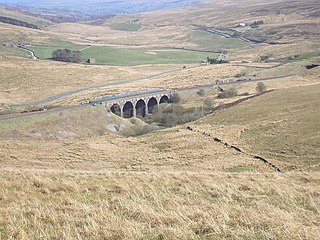
The Hawes Junction rail crash occurred at 5.49 am on 24 December 1910, just north of Lunds Viaduct between Hawes Junction and Aisgill on the Midland Railway's Settle and Carlisle main line in the North Riding of Yorkshire, England. It was caused when a busy signalman, Alfred Sutton, forgot about a pair of light engines waiting at his down (northbound) starting signal to return to their shed at Carlisle. They were still waiting there when the signalman set the road for the down Scotch express. When the signal cleared, the light engines set off in front of the express into the same block section. Since the light engines were travelling at low speed from a stand at Hawes Junction, and the following express was travelling at high speed, a collision was inevitable. The express caught the light engines just after Moorcock Tunnel near Aisgill summit in Mallerstang and was almost wholly derailed.

Radio Electronic Token Block is a system of railway signalling used in the United Kingdom. It is a development of the physical token system for controlling traffic on single lines. The system is slightly similar to North American Direct Traffic Control, which unlike RETB does not have a cab display unit.

The Abermule train collision was a head-on collision which occurred at Abermule, Montgomeryshire, Wales on Wednesday 26 January 1921, killing 17 people. The crash arose from misunderstandings between staff which effectively over-rode the safe operation of the Electric Train Tablet system protecting the single line. A train departed carrying the wrong tablet for the section it was entering and collided with a train coming the other way.
Australian railway signalling varies between the States of Australia, because the individual States are responsible for the railway systems within their own borders, with, historically, no need to co-ordinate between states except at the boundaries.

Rule 55 was an operating rule which applied on British railways in the 19th and 20th centuries. It was superseded by the modular rulebook following re-privatisation of the railways. It survives, very differently named: the driver of a train waiting at a signal on a running line must remind the signaller of its presence.
The Winwick rail crash took place at Winwick Junction, near Warrington on the London, Midland and Scottish Railway, on 28 September 1934. Two trains collided, resulting in 11 deaths and 19 injured.

The Clayton Tunnel rail crash occurred on Sunday 25 August 1861, five miles (8 km) from Brighton on the south coast of England. At the time it was the worst accident on the British railway system. A train ran into the back of another inside the tunnel, killing 23 and injuring 176 passengers.
The Ais Gill rail accident occurred on the Settle–Carlisle line in Northwest England on 2 September 1913. Two long trains were both ascending a steep gradient with some difficulty, because their engines generated barely enough power to carry the load. When the first train stopped to build-up steam pressure, the driver and fireman of the second train were distracted by maintenance routines, and failed to observe the warning signals. The collision wrecked several carriages, which were then engulfed by flammable gas, killing 16 people and injuring 38.
The Radstock rail accident took place on the Somerset and Dorset Joint Railway in south west England, on 7 August 1876. Two trains collided on a single track section, resulting in fifteen passengers being killed.
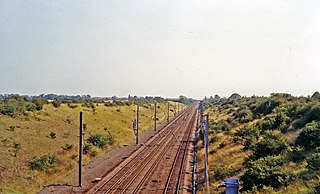
The Abbots Ripton rail disaster occurred on 21 January 1876 at Abbots Ripton, then in the county of Huntingdonshire, England, on the Great Northern Railway main line, previously thought to be exemplary for railway safety. In the accident, the Special Scotch Express train from Edinburgh to London was involved in a collision, during a blizzard, with a coal train. An express travelling in the other direction then ran into the wreckage. The initial accident was caused by:

Mechanical railway signalling installations rely on lever frames for their operation to interlock the signals, track locks and points to allow the safe operation of trains in the area the signals control. Usually located in the signal box, the levers are operated either by the signalman or the pointsman.
The Battersea Park rail crash occurred on 2 April 1937, just south of Battersea Park railway station on the Southern Railway, in London, England. Two electrically driven passenger trains collided on the Up Local line; the second train, from Coulsdon North to Victoria, had been allowed into the section while it was still occupied by the first train, from London Bridge to Victoria. The signalman at Battersea Park, G. F. Childs, believing there was a fault with the Sykes electromechanical interlocking apparatus which was installed at the box, had opened up the case of the instrument and inadvertently cleared the interlock which should have prevented this situation. The official enquiry ruled that he subsequently accepted the Coulsdon train, although he should have been aware that the London Bridge train had not cleared the section. Ten people were killed, including the guard of the London Bridge train, and eighty people were injured, seven sustaining serious injuries. Another accident had occurred at Battersea Park in 1881.

Ledbury Signal Box is a typical Great Western Railway traditional lever frame signal box which remains in daily use at Ledbury Station, Herefordshire, England on the railway line from Worcester to Hereford.
The Welwyn Tunnel rail crash took place in Welwyn North Tunnel, north of Welwyn station on the Great Northern Railway, on 9 June 1866. According to L T C Rolt, "from the point of view of damage to engines and rolling stock it was one of the most destructive in railway history."

A rail operating centre (ROC) is a building that houses all signallers, signalling equipment, ancillaries and operators for a specific region or route on the United Kingdom's main rail network. The ROC supplants the work of several other signal boxes which have thus become redundant.

There are around 6,000 level crossings in the United Kingdom, of which about 1,500 are public highway crossings. This number is gradually being reduced as the risk of accidents at level crossings is considered high. The director of the UK Railway Inspectorate commented in 2004 that "the use of level crossings contributes the greatest potential for catastrophic risk on the railways." The creation of new level crossings on the national network is banned, with bridges and tunnels being the more favoured options. The cost of making significant reductions, other than by simply closing the crossings, is substantial; some commentators argue that the money could be better spent. Some 5,000 crossings are user-worked crossings or footpaths with very low usage. The removal of crossings can improve train performance and lower accident rates, as some crossings have low rail speed limits enforced on them to protect road users. In fact, between 1845 and 1933, there was a 4 miles per hour (6.4 km/h) speed limit on level crossings of turnpike roads adjacent to stations for lines whose authorising Act of Parliament had been consolidated in the Railways Clauses Consolidation Act 1845 although this limit was at least sometimes disregarded.